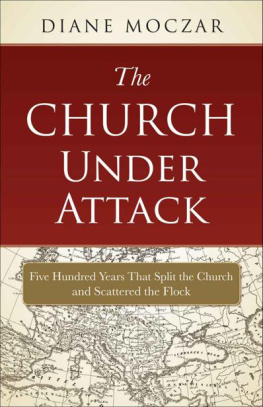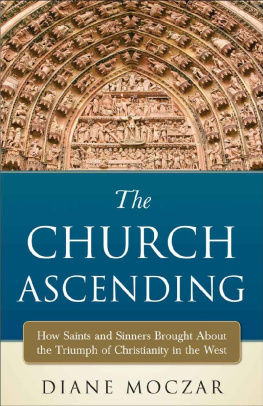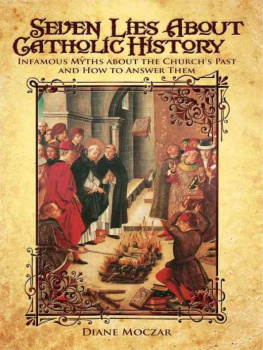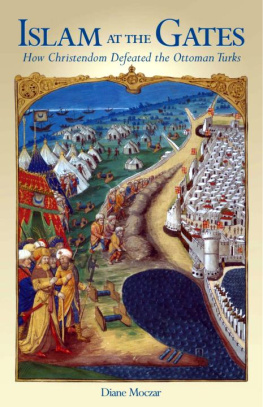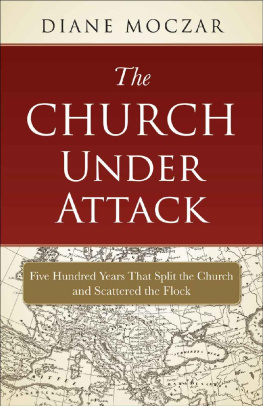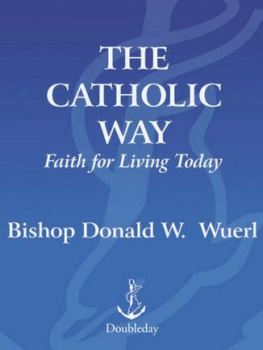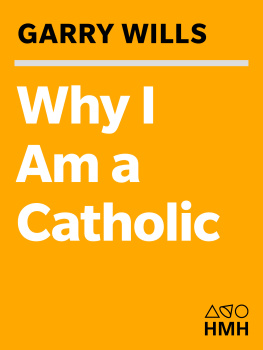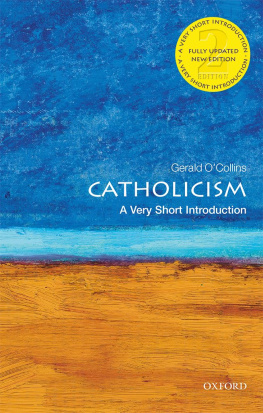Diane Moczar - The Church Under Attack: Five Hundred Years That Split the Church and Scattered the Flock
Here you can read online Diane Moczar - The Church Under Attack: Five Hundred Years That Split the Church and Scattered the Flock full text of the book (entire story) in english for free. Download pdf and epub, get meaning, cover and reviews about this ebook. year: 2013, publisher: Sophia Institute Press, genre: Religion. Description of the work, (preface) as well as reviews are available. Best literature library LitArk.com created for fans of good reading and offers a wide selection of genres:
Romance novel
Science fiction
Adventure
Detective
Science
History
Home and family
Prose
Art
Politics
Computer
Non-fiction
Religion
Business
Children
Humor
Choose a favorite category and find really read worthwhile books. Enjoy immersion in the world of imagination, feel the emotions of the characters or learn something new for yourself, make an fascinating discovery.
- Book:The Church Under Attack: Five Hundred Years That Split the Church and Scattered the Flock
- Author:
- Publisher:Sophia Institute Press
- Genre:
- Year:2013
- Rating:4 / 5
- Favourites:Add to favourites
- Your mark:
- 80
- 1
- 2
- 3
- 4
- 5
The Church Under Attack: Five Hundred Years That Split the Church and Scattered the Flock: summary, description and annotation
We offer to read an annotation, description, summary or preface (depends on what the author of the book "The Church Under Attack: Five Hundred Years That Split the Church and Scattered the Flock" wrote himself). If you haven't found the necessary information about the book — write in the comments, we will try to find it.
The Church Under Attack: Five Hundred Years That Split the Church and Scattered the Flock — read online for free the complete book (whole text) full work
Below is the text of the book, divided by pages. System saving the place of the last page read, allows you to conveniently read the book "The Church Under Attack: Five Hundred Years That Split the Church and Scattered the Flock" online for free, without having to search again every time where you left off. Put a bookmark, and you can go to the page where you finished reading at any time.
Font size:
Interval:
Bookmark:
Diane Moczar
The Church Under Attack
Five Hundred Years That
Split the Church and
Scattered the Flock
SOPHIA INSTITUTE PRESS
Manchester, New Hampshire
Copyright 2013 Diane Moczar
Printed in the United States of America
All rights reserved
Cover design by Carolyn McKinney
On the cover: Historical Map of Europe (62807983),
pio3, used under license from Shutterstock.com.
No part of this book may be reproduced, stored in a retrieval system,or transmitted in any form, or by any means, electronic, mechanical,photocopying, or otherwise, without the prior written permission of the publisher, except by a reviewer, who may quote brief passages in a review.
Sophia Institute Press
Box 5284, Manchester, NH 03108
1-800-888-9344
www.SophiaInstitute.com
Sophia Institute Press is a registered trademark of Sophia Institute.
Library of Congress Cataloging-in-Publication Data
Moczar, Diane.
The church under attack : five hundred tears that split
the church and scattered the flock / Diane Moczar.
pages cm
Includes bibliographical references.
ISBN 978-1-933184-93-7 (pbk. : alk. paper)
ePub ISBN 978-1-622821-64-8
1. Catholic Church History Modern period, 1500-
2. Church history Modern period, 1500- I. Title.
BX1304.M56 2013
282.09'03 dc23
2013004100
Contents
Introduction
For anyone who studies the history of the West, particularly the history of the Church, the early period of that history, from the civilizations of Greece and Rome through the High Middle Ages, presents a marked contrast to the later period. Europe in the early period seems to progress from one cultural development to the next, as the Greek achievement is absorbed, preserved, and spread by Rome, as Christianity rises and flourishes, as the nations of Europe take shape and astonishing spiritual, intellectual, artistic, scientific, legal, governmental, and literary milestones are reached. Of course there are times of upheaval, war, and natural disaster, but the general course of civilization appears to be upward. For the Church in particular, progress is apparent in every area. It is true that the earliest Christian centuries saw the rise of formidable challenges to the Faith in the form of the great heresies such as Arianism, but those had been largely vanquished in the early centuries. Later sects came and went without seriously damaging the unity and harmony of Christendom. The creation of Catholic civilization throughout Europe, the development of Catholic social, economic, and political thought and institutions, the great masterpieces of Catholic art, architecture, philosophy, and literature are all features of that first period of European history.
With the sixteenth century, all this begins to change dramatically. The first of a series of great spiritual, intellectual, and cultural crises arises: the Reformation. It will be followed in subsequent centuries by other major assaults on Catholic belief and thought, assaults that have continued into our own time. It is the purpose of this book to trace the pattern of this later period of Western history, with particular emphasis on the state of the Church from the sixteenth to the mid-twentieth century, and to examine the major attacks on the Church in both early-modern and modern times. We must keep in mind, of course, that Catholic culture and the Western civilization that it formed did not dry up and blow away during the past few centuries. Great Catholic writers, scholars, scientists, rulers, and saints can be found in more recent times as well as in the distant past. It is true, as we shall find, that modern civilization on the whole has become deficient in many of the principles moral, aesthetic, political, and spiritual that lay at the heart of the Catholic civilization of the past, although the situation may not yet have reached the point of no return. Our task here is to examine how the events of the past few hundred years have shaped the present, both spiritually and temporally.
For each of the centuries discussed in this book, we will examine the major historical developments, including the wars, economic growth, achievements, and major cultural and political issues of concern to the people then living. We will especially focus on the condition of the Church in each period. Since it is people, and not impersonal forces, that make history, we will meet the kings, explorers, adventurers, villains, and saints of each period. Because our survey of modern history will necessarily be a cursory one otherwise we would need several volumes for each century many fascinating people and developments will receive briefer treatment than the reader might desire. This is why a few suggestions for further reading are included for each chapter, at the end of the book; they are by no means exhaustive treatments of the various topics, but most of them will lead the interested reader to a great many more works.
Chapter 1
The Busy Sixteenth Century
The trouble with the sixteenth century is that the people living in it did far too much. Harried teachers faced with squeezing their doings into a tidy lecture would love to give them some advice: Stop doing things! Leave something for the next century!
But no, the sixteenth-century populace wouldnt listen. Look to the west from Europe. There they go, beetling around Africa in their newfangled ships, getting seasick on the Atlantic routes to America, and staring openmouthed at the Pacific. Look east. There they are, warring with the Turks and winning battles too important for us to ignore. In India and the Americas they are planting colonies and creating empires, while fighting wars in Europe. And in northern Germany, a neurotic monk with a hammer in his hand and a couple of nails between his teeth is getting ready to tack a piece of paper to the door of a church. We wont be able to ignore him either. To make it worse, there were others who spent their part of the century scribbling plays with names such as Macbeth and Othello or novels such as Don Quixote . And the century was so chock-full of spectacular saints, heroes, and villains that, like its wars of religion, they spill over into the next century.
We will deal first, in short, with the Reformation. Here I am using a conventional term, although the movement is more justly called the Protestant Revolution; some authors use Protestant Reformation and Catholic Reformation , but the more familiar terms seem to be Protestant Reformation and Catholic Counter-Reformation . I use the term Reformation , then, to mean the development, in the sixteenth century, of new religions organized in opposition to Catholicism. By the end of the century there would be dozens of new sects, but we will deal primarily with the three major ones: Lutheranism, Calvinism, and Anglicanism.
To start with poor Martin Luther, a psychologically complex monk with an intractable sense of guilt: we first find him in 1517 posting his famous ninety-five theses on the church door in Wittenberg, a traditional practice intended to signify that the hammerer wanted to open a debate on his ideas. If we asked Father Luther what he meant to accomplish, he would say, after he had spat out the nails and was in a position to answer us, that he wanted to publicize his criticisms of Catholicism and to make known the new doctrines he had been inventing for the last few years.
The myth about Martin Luther is that he was scandalized by the terrible corruption in the Catholic Church. He had been to Rome and saw the popes and cardinals living in luxury and vice, spending the money extracted from the faithful on pagan art to beautify Rome. He was shocked that the German clergy were not only depraved but teaching doctrines invented by the Roman popes that had little to do with real Christianity, and he wanted a return to apostolic purity of faith and morals. He was especially indignant about the new preaching of indulgences in Germany (the German states of the Holy Roman Empire): people were encouraged to pay money in return for time off in purgatory for themselves or the release from purgatory of their deceased relatives.
Next pageFont size:
Interval:
Bookmark:
Similar books «The Church Under Attack: Five Hundred Years That Split the Church and Scattered the Flock»
Look at similar books to The Church Under Attack: Five Hundred Years That Split the Church and Scattered the Flock. We have selected literature similar in name and meaning in the hope of providing readers with more options to find new, interesting, not yet read works.
Discussion, reviews of the book The Church Under Attack: Five Hundred Years That Split the Church and Scattered the Flock and just readers' own opinions. Leave your comments, write what you think about the work, its meaning or the main characters. Specify what exactly you liked and what you didn't like, and why you think so.

